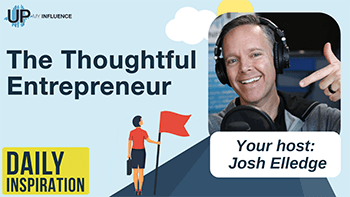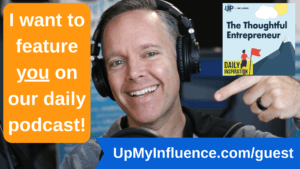THE THOUGHTFUL ENTREPRENEUR PODCAST
In this episode of the Thoughtful Entrepreneur, your host Josh Elledge speaks to the CEO & Founder of ThrillX, Arsh Sanwarwala.
Arch's journey into the world of design is rooted in his background in business and marketing. He quickly recognized that the key to successful design isn't just about aesthetics; it's about making data-driven decisions that drive business impact. This philosophy is at the heart of Thrill X's approach, and it's what sets them apart in the competitive landscape of digital design.
Arch pointed out a common pitfall among many agencies and web developers: the tendency to prioritize visual appeal over functionality and effectiveness. While a stunning website can capture attention, it's the data-centric approach that truly optimizes user experience and conversion rates. This is where Thrill X shines, bridging the gap between good design and tangible business results.
Arch was generous enough to share some actionable tips for businesses looking to adopt a data-driven design strategy. He stressed the importance of both quantitative and qualitative research tools, as well as the application of human psychology and behavioral science principles.
By tracking user behavior and analyzing data, businesses can make informed decisions that enhance the user experience and, ultimately, their bottom line.
Key Points from the Episode:
- Introduction to UpMyInfluence.com and its podcast opportunities
- Overview of Thrill X and its focus on UX/UI design and conversion optimization
- Emphasis on the importance of data-driven decision-making in design and business
- Discussion on the common approach of agencies and web developers towards design
- Actionable tips for taking a data-centric approach to design and development
- Specific example of the impact of conversion optimization on a company's business
- When businesses should consider engaging with Thrill X for their services
- Exploration of cognitive load theory and its importance in simplifying user experience
- Services offered by Thrill X, including website reviews and audits
About Arsh Sanwarwala:
Arsh Sanwarwala is the visionary Founder and CEO of ThrillX, driven by a lifelong passion for entrepreneurship. With a keen eye for human-centered design solutions, Arsh has dedicated his career to elevating businesses through innovative digital strategies.
He found that many big companies do not use their websites and mobile apps to their fullest potential. This is a common problem he has seen in his work with Fortune 500/1000 companies.
At ThrillX, Arsh's mission is clear: to bridge the gap between visual appeal and functionality in design, ensuring each project maximizes business goals. He deeply understands users, their problems, and uses design thinking to meet their needs.
Arsh Sanwarwala's commitment to helping businesses thrive is reflected in ThrillX's commitment to creating designs that are not only visually striking but also user-friendly and results-driven.
About ThrillX:
ThrillX stands out as a premier digital agency, specializing in the definition, design, and development of transformative user experiences for websites and mobile applications.
With a core focus on user experience (UX) design, ThrillX adopts an innovative approach to crafting digital solutions that are not only immersive but also geared towards driving business growth.
The agency excels in creating future-proof designs that prioritize user engagement and conversion. ThrillX's commitment to staying at the forefront of digital trends ensures that their clients receive cutting-edge solutions tailored to their unique needs.
Through a strategic blend of creativity and functionality, ThrillX is dedicated to delivering user-centric, visually compelling, and business-driven digital experiences.
Links Mentioned in this Episode:
Want to learn more? Check out ThrillX website at
Check out ThrillX on LinkedIn at
https://www.linkedin.com/company/thrillx-ux-ui-design-agency/
Check out ThrillX on Instagram at
https://www.instagram.com/thrillxdesign/
Check out ThrillX on Twitter at
https://twitter.com/ThrillXDesign
Check out ThrillX on Facebook at
https://www.facebook.com/people/ThrillX-UXUI-Design-Agency/100083366589095/
Check out Arsh Sanwarwala on LinkedIn at
https://www.linkedin.com/in/arsh-sanwarwala/
More from UpMyInfluence:
We are actively booking guests for our The Thoughtful Entrepreneur. Schedule HERE.
Are you a 6-figure consultant? I’ve got high-level intros for you. Learn more here.
What is your #1 Lead Generation BLOCKER? Take my free quiz here.
Want to learn more about all the podcasts managed by UpMyInfluence? Opt in here.

